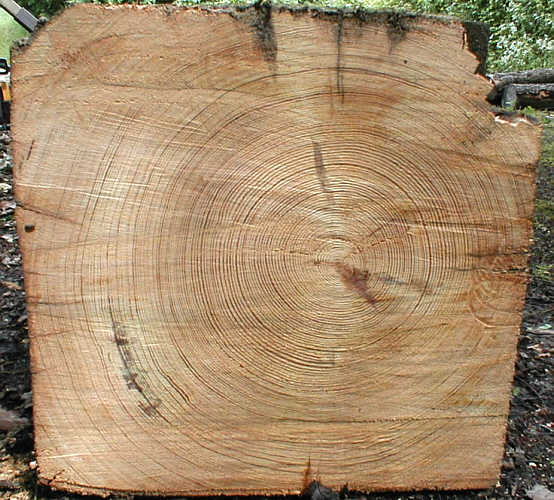 |
| Tree
Rings
A cursory look at these well known features By Paul James, UK |
I think everyone knows that trees lay one growth ring per year, and by counting them from the pith to the bark we can find out the tree's age.
 |
The photo above shows the exposed end of an old 16"x16" pine beam, ( loosely termed pitch pine); probably originally grown in Russia where the severe cold restricts the growth and therefore thickness of each ring laid per season. Many of these old beams were cut from trees having as many as 200 - 300 rings, yet the diameter of the trees may well be no more than 2.5 feet at the butt. The photo's below demonstrate the variation in growth ring thickness between species.
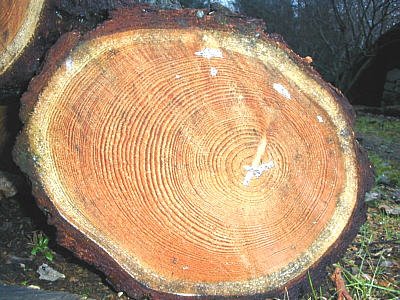 |
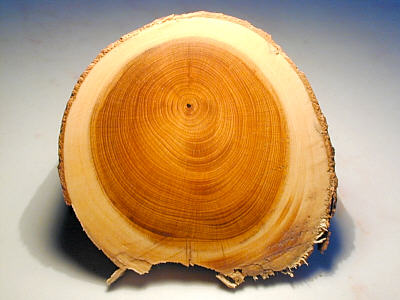 |
| (x0.3) Larch ( Larix decidua ) 11" Diameter 90 Rings | (x1.5) Yew (Taxus baccata) 2" Diameter 65-70 rings |
 |
| (x6) Document
scanner image of yew above showing approximately 65-70 rings.
Ring width in the older sapwood region is very small and indistinct here. |
Ring thickness' can vary from approximately 1" to 0.02" depending on varying factors such as growing conditions, soil fertility, temperature, rainfall, and whether grown in the open or woodland, character of individual species and also the tree's age. Young trees tend to lay down wider rings because the tree is more vigorous in youth* , older specimens lay down narrower rings in later years. Sudden increases in thickness in later years usually indicates more light in the canopy of the tree owing to thinning of woodland etc..
[ *The number of cells laid down each year appears to decrease, but as the tree's girth increases the same number of cells laid down would produce narrower rings simply because the increase in the tree's circumference in later years requires a proportionally greater number of cells to be laid if ring thickness is maintained. The nutrimental input from the tree's surroundings to sustain constant ring growth thickness cannot be supported, and so the ring growth thickness diminishes proportionally. Thus the term 'old' when applied to trees does not infer senility! ]
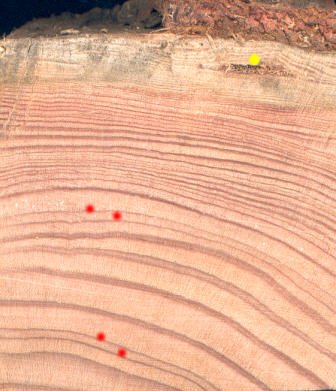 |
| x1.5 Larch. Ring
growth varies considerably.
Thin rings as shown tend to be caused by early warm spells in spring. Sap pockets like this one caused by insect or mechanical injury to bark. |
So the rings, and their relative thickness can tell us something about the tree, but the rings themselves vary in structure, and the trees can be divided into 2 basic categories :-1) Softwoods ( A vague term and not entirely accurate, some are quite hard i.e. yew. )
2) Hardwoods ( As above, with balsa wood being an obvious exception. )
The two classes are recognised by their respective cellular structures.
Softwoods ( The Gymnosperms )
Closer examination of rings in softwoods reveals a distinct two part structure. The inner lighter toned ring is that laid down during early spring growth, and is known as spring wood. This is relatively soft and the cells ( tracheids ) are thin walled and carry sap. The outer ring, sometimes being quite dark is usually a harder band and is laid in summer; it is called summer wood. These Tracheids are thick walled and provide rigidity and stability to the bole. The change from the thin wall to the thick wall tracheid can be very rapid as in Douglas fir, or more gradual as in Scots pine. Other softwoods such as the firs, spruces etc., display growth rings which are not so distinct, because the summer wood is pale.
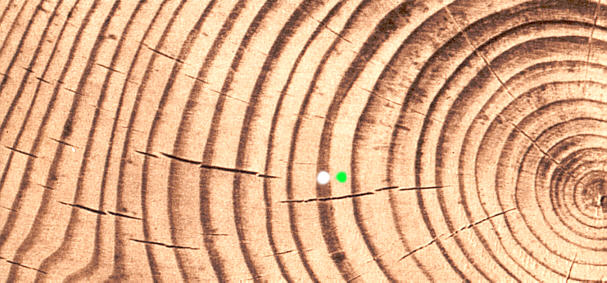 |
|
Note that the summerwood and spring wood have different relative thickness' depending upon weather conditions that year. Note excess production of resin which bleeds into the ring structure as seen above right side. |
Hardwoods (The Angiosperms )Whilst the growth rings in hardwoods resemble those in softwoods, there are some structural differences. Hardwoods possess 'vessels or 'pores' in their ring structure to carry sap up the trunk. These 'vessels are in effect tubes, running the length of the tree, and are laid down during the years growth. Some hardwoods tend to lay down large vessels early in spring, and smaller ones in summer, and they are characteristically known a 'ring porous' woods:-
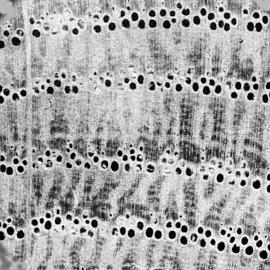 |
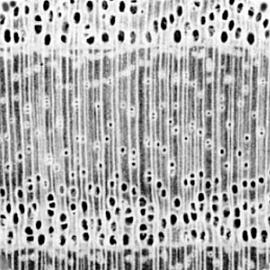 |
| OAK
( Quercus Pedunculata ) x6
Pith Below |
ASH
( Fraxinus Excelsior ) x12
Pith Below |
Other examples of ring porous timbers are.......... elm, teak, sweet chestnut, and robinia.Other hardwoods lay their vessels more uniformly throughout the growing season, and their rings are known as 'diffuse porous'. Trees grown in tropical regions have long growth periods, and some species show little or no evidence of ring structure :-
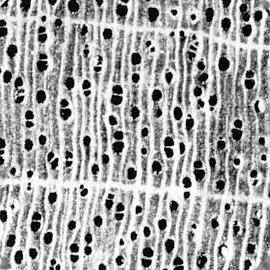 |
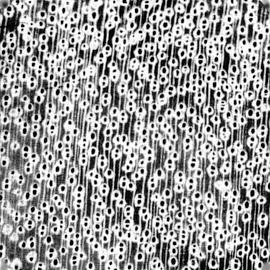 |
| Mahogany (Swietenia
macrophylla) x12
Pith Below |
Greenheart (
Ocotea
rodiaei ) x12
Pith Below Growth rings virtually absent |
Other examples of diffuse porous timbers :-Beech, sycamore, plane, alder, walnut, utile, willow, holly, cherry, maple, birch etc.
Microscopic examination
Whilst tree rings are fairly obvious to the naked eye, closer examination with a x5 - x15 loupe reveals a great deal of structural information. A stereo low power 'scope is ideal for this.
Here are two ways of preparing wood for closer scrutiny :-
Simple method for very low powers
The easiestby far is to cut and plane the end grain, using a finely honed cutting edge. Sanding even with very fine papers tends to yield a woolly surface in some of the softer timbers, so cutting or slicing with a very keen blade is best. It is easiest to treat the end grain first by clamping the wood sample in a vice, then cut a moderately thin section off the end after its surface is smooth . A fresh hacksaw blade is ideal for this, but requires some care to avoid the section crumbling. Lubricate with water if necessary.
One unorthodox method which I have used is to prepare the end grain fairly well and then coat with clear polyurethane varnish or preferably a clear epoxy resin. Leave to harden for a day or two, then treat surface with moist fine wet and dry emery paper. The varnish/resin holds the cell ends firmly whilst sanding is carried out, and provides an optical window for the low power 'scope. Covering with a coverslip well moistened with water allows best transparency.
You might find some timbers best cut wet and examined after drying?
Using vertical illumination will reveal much of the structural characteristics, as well as any flaws in the cutting process too! Brightfield illumination will be satisfactory if the section is fairly thin and flooded with water, overlaid with a coverslip.
Thin sections and wood treatment
Preparation of thin sections for slide mounting is not an easy task, and ideally requires a sledge microtome, though a standard handheld one can be used provided the wood is softened first.
Softening the wood is often required and this can be done by simply boiling the wood sample in water until the sample sinks. Keep everything moist whilst slicing the sections. Never let the softened section dry out, and always use a coverslip to allow inspection to be carried out with the surface in a flooded state, to gain maximum contrast and optical clarity etc. Using a 50/50 solution of glycerine and water helps prevent drying out, and improves imagery too.
1% safranine solution will stain the lignin red if desired. I have never mounted thin sections but presumably dehydration would be required in ethanol etc., prior to permanent placement in a suitable mountant.
Examination using the document scanner
I have found images obtained from my Agfa E50 document scanner to be perfectly adequate for routine inspection of wood surfaces. Document scanners have the advantage over optical microscopes of having great depth of field or 'focus'. So treated wood samples need not be perfectly flat. So long as the face to be scanned is reasonably plane and smooth, the rest of the specimen's form is unimportant, and does not hinder as would if lying upon a stage.
High resolution scans in the order of 2000 dpi are perfectly feasible and yield surprising detail and information, and provide a very convenient method of imaging.
-------------
Tree rings provide interest because of their link with time and weather patterns, so direct observation, macro, and micro representations yield much for us to ponder upon. There is something of interest in this subject for both the casual observer and the keen botanist. Anyone who finds the subject particularly fascinating should also pursue the subject of dendrochronology which attends to the study of tree ring dating etc..
| All images taken using Nikon Coolpix 800 digicam, Agfa
e50 document scanner and
B&W images scanned from 5x4 negs. |
| All Comments welcomed to the author Paul James are welcomed. |
Please report any Web problems
or offer general comments to the
Micscape
Editor,
via the contact on current
Micscape Index.
Micscape is the on-line monthly
magazine of the Microscopy UK web
site at Microscopy-UK
WIDTH=1